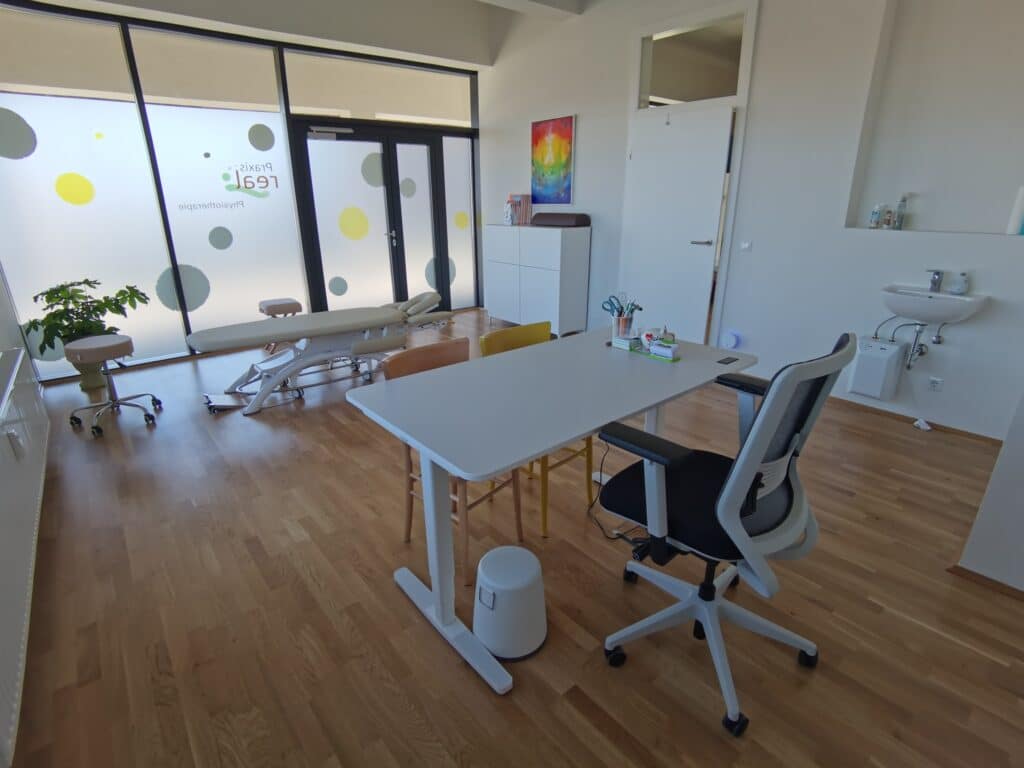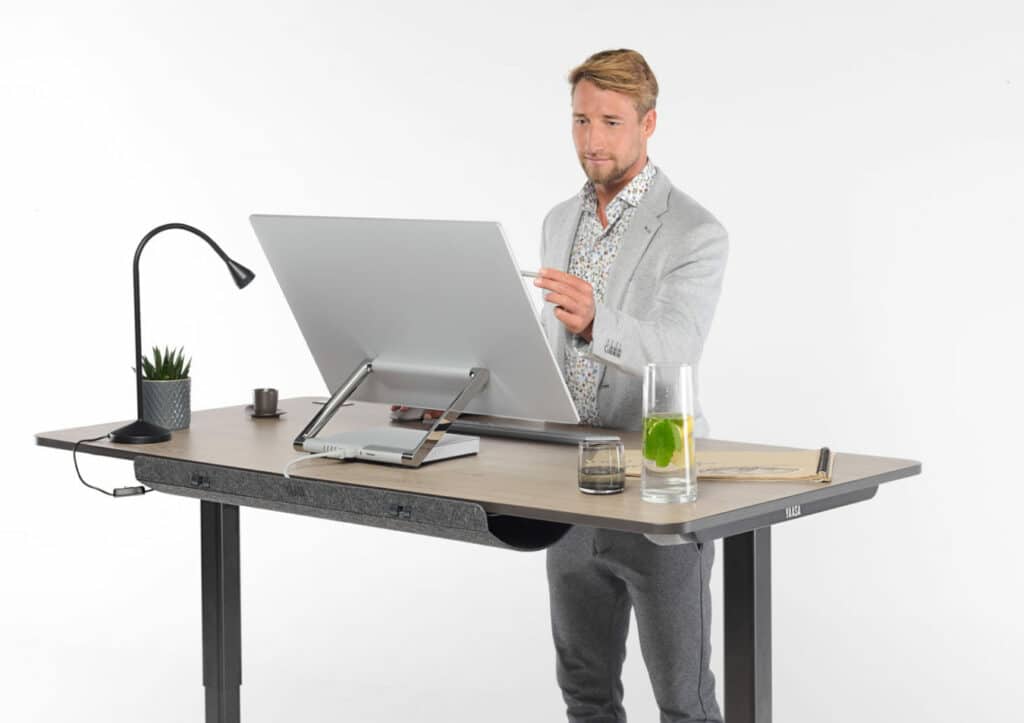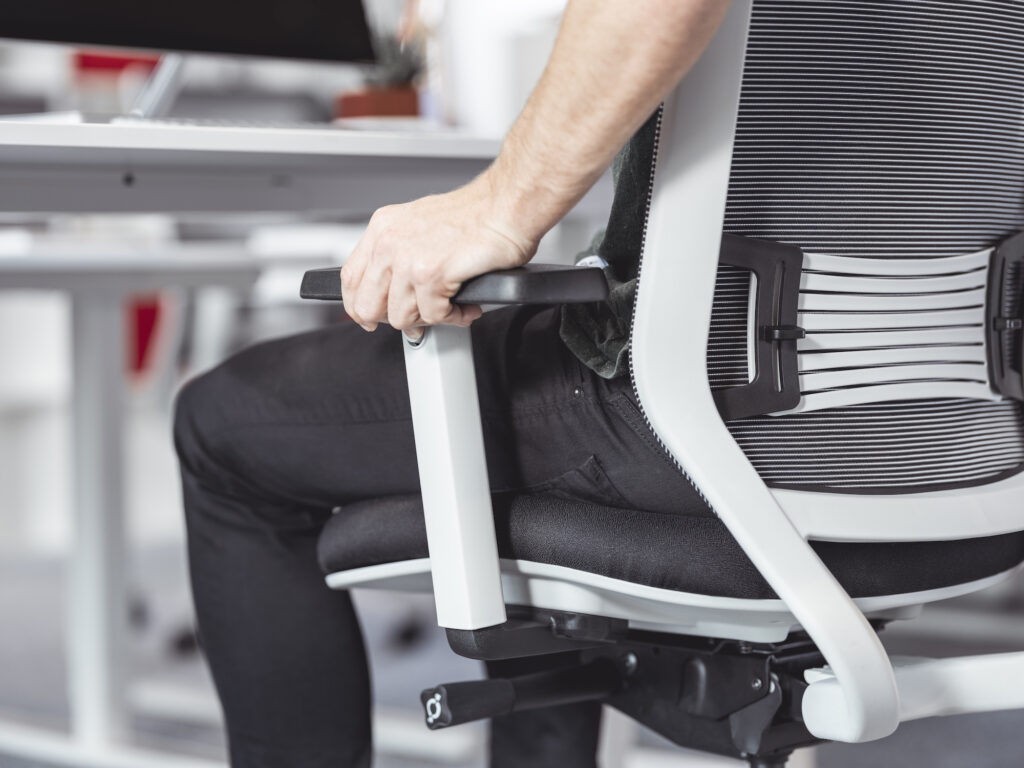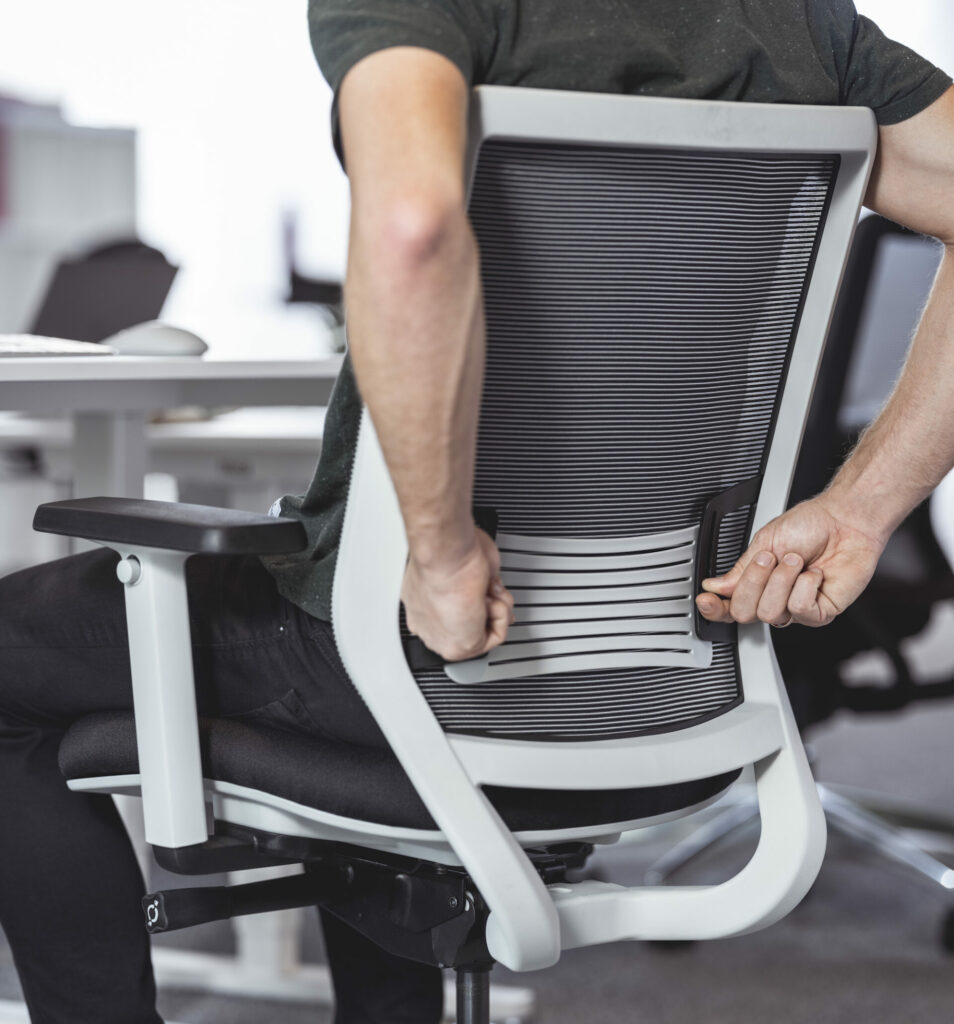Tips from a physiotherapist: An ergonomic and healthy workplace
Martina Goliasch is a physiotherapist with many years of experience in treating trauma surgery and orthopaedic patients as well as patients with spinal problems. In April 2021, she founded the practice Real in Graz - under the motto "Movement is life". With her wide range of therapies, she helps her patients to carry out all their everyday activities, work or sport more easily or without pain and to improve their mobility and posture.
In a detailed discussion, Martina told us how a workplace should be set up in order to be able to work ergonomically and healthily. She also explained to us which health complaints can arise from non-ergonomic office equipment and gave us numerous tips on ergonomic working and ergonomics in the workplace.

Physiotherapist Martina Goliasch treats patients with spinal problems, among other things
Yaasa: As a physiotherapist and therefore an expert in physical health, I'm sure you can tell us how to set up your own desk workstation in order to be able to work ergonomically.
Martina: The most important thing about a desk workstation is that the height of the office furniture can be adjusted. We are all different sizes, so it should be possible to adjust the seat height and desk height to suit each individual. Adjusting the screen is also important.I often notice that patients who only work on a laptop are always looking down. It's an advantage if you can vary the position and move the desk to a standing position when reading, for example, and adjust the desk again when writing.
If you also have a second monitor in addition to a laptop, the two devices should ideally be positioned at different heights. To do this, you can place the monitor on a monitor riser and thus position the two screens on two different levels. The screen height is very important, especially for the neck. In addition to the desk height and the screen position, the seat height is also crucial. To be able to sit ergonomically, the buttocks should be positioned slightly higher than the knees.
Yaasa: In addition to an adjustable office chair and height-adjustable desk, what other office accessories do you need to create an ergonomic workplace?
Martina: An ergonomic keyboard that can be adjusted in height and a wrist rest are helpful. Many of my patients have wrist problems and I advise them to raise the keyboard slightly. While wrist rests cushion the edge when you rest your arms on the table, raising the back of the keyboard creates a sloping surface. This makes it much easier and more comfortable to rest your hands on the keyboard and write more comfortably.
If you don't have an ergonomic keyboard or laptop stand, you can use a simple trick byplacing the keyboard on a folder. As the folder has an inclined plane, the keyboard is slightly raised. The same works with a laptop: placing the laptop on the folder raises it slightly, the keyboard is at an angle and you can rest your arms on it. At the same time, the screen is also slightly higher.

The Real practice in Graz: Physiotherapist M. Goliasch's workplace equipped with Yaasa office furniture
Yaasa: What are the most common health complaints that can arise due to a non-ergonomically equipped workstation?
Martina: The complaints mainly affect the neck because many of my patients don't work at height-adjustable desks and the static desks are only set at one height. In such cases, I always advise my patients to at least raise the monitor to a higher level with the help of a monitor riser so that they don't have to look down for the entire working time. A guideline says that the monitor should be positioned so that the eyes are aligned with the upper edge of the screen. Then you can cover the entire screen with your eyes.
Many people also don't have an ergonomic office chair: office equipment is not ideal, especially when working from home. However, you should at least have a simple swivel chair at your workplace. This is important because monitors are often not positioned in the middle of the desk, but on the side of the desk. With a swivel chair, you can then simply turn towards the screen and align your body in its direction, because from an ergonomic point of view, you should always be able to sit facing the monitor.
If you don't have an ergonomic office chair or swivel chair, I advise my patients to occasionally turn the chair with the backrest facing the desk and sit on the chair in a rider's seat. The back of the chair serves as a support that you can lean on while your hands remain free to work and your back is relieved at the same time.
Yaasa: Can neck pain or other complaints caused by incorrect posture at work always be treated or can they develop into long-term complaints?
Martina: If you sit at your desk for 8 to 10 hours a day and also sit incorrectly, then it is very likely that permanent complaints and tension will occur. Many people also have problems sleeping as a result: If you adopt an incorrect head position throughout the day, then it is often difficult to find the right position for your head at night. It is therefore important to adjust the desk height, monitor height and sitting position, as this takes a lot of strain off the body.
Yaasa: What impact has the pandemic and the move to working from home had on the physical health of employees?
Martina: Working from home and the coronavirus situation have significantly increased the number of patients with complaints caused by non-ergonomic office equipment. The reason for this is that offices are often much better equipped and employers often do a lot for their employees in terms of ergonomic office equipment. Most people are not so well equipped at home and have to work at the kitchen table or coffee table.
However, the complaints and their frequency also depend on how much compensation people have. You can tell if it's a sporty person who gets their balance through exercise and sport: this person naturally feels a lot better. But if you lie down on the couch after work and look at your cell phone or play on the computer, your body is put under more strain than if you have a balance. That's why it's a huge bonus to have a height-adjustable desk so that you can change your posture and move around during working hours. However, both would be ideal: alternating between sitting and standing at work as well as additional compensation after working hours, e.g. through sport.
Yaasa: Which types of sport are best suited to compensating for prolonged or non-ergonomic sitting?
Martina: It doesn't matter, the main thing is to get your body moving. It doesn't have to be a performance activity, but simply a compensation with movement - in whatever form. I always advise my patients to do what they enjoy. Because if it's not fun, they won't want to do it. Some people prefer cycling, while others prefer walking, hiking, swimming or yoga. The type of sport doesn't matter, because it's all about being active and having fun.
Yaasa: How often should you alternate between sitting and standing in a working day to get enough exercise during working hours?
Martina: Clearly: every hour! If you get up every hour and move around for 5 to 10 minutes or work standing up for a while, it takes the strain off your body. When we sit, our body is always in the same position, whereas straightening up, moving and working standing up puts the spine in a different position.
To relieve the body, you should get up every hour during work, move around and work standing up for a while.

Yaasa: Is it possible to stand for too long?
MartinaYes, of course you can stand for too long. But this is mainly the case for people who mainly do standing work, such as waiters or salespeople. If you stand for too long, the muscles in your spine become tired and need to recover after a while. You notice this when you no longer stand up straight, but instead slouch or slump down, which puts more strain on the body.
However, if you have a sedentary job, you should ideally get up every hour, move around and work standing up for a while. If you work at a standing desk, you have to decide for yourself how much standing is good for you personally and how long you feel comfortable doing it.
Yaasa: You have been working with Yaasa office furniture for some time now. What experiences have you had with the Chair and Desk Pro 2 so far?
MartinaYes, that's right. First of all, I have to say that I really like the look of the office chair and the desk and that they fit very well into my practice, both in terms of color and size. I mainly use the Yaasa desk for patient consultations, anamnesis and documentation. I opted for the smallest Pro 2 in the size 139 x 75cm and have to say that I have enough space to work comfortably on my laptop and with documents.
With the YaasaChair , I was particularly impressed by the seat depth adjustment. As I have shorter legs, I adjusted the seat depth to suit me and set it relatively short. In general, I think it's great that everything on the office chair is very easy to adjust and can be set in different directions. If the adjustment is quick and easy, then you will make use of the various adjustment options and adapt the ergonomic office chair to suit you. However, if, for example, the backrest or armrests are difficult and laborious to adjust, as is the case with some office chairs, then you will only adjust them once and leave them as they are.
The quick and easy adjustment is very important to me as a physiotherapist because my patients often sit down on my Yaasa office chair and I show them how to adjust their office chair ergonomically and sit correctly in the office or at home. Many people position the armrests too high, for example, and on the Yaasa Chair I can easily adjust the 3D armrests in different directions and demonstrate to my patients how they can adjust them correctly and adapt them to their body.
The uncomplicated adjustment is also very important when working from home: There are often two people sharing a workstation and the office chair always has to be adjusted to the body of the respective person. This is also an advantage in offices, as office workstations are nowadays often used by two part-time employees, for example. In this case, it makes sense to have an office chair that is easy to adjust and can be quickly and easily adapted each time.

The height and alignment of the armrests on the Yaasa Chair can be changed and adjusted quickly and easily.
Yaasa: You are enthusiastic about the simple adjustment options of the Yaasa Chair, but would you also describe it as a truly ergonomic office chair?
MartinaYes, definitely! I've sat on a lot of office chairs and I've tried a lot of them - for example, when I was choosing chairs for my children and their nursery. That's when I realized that there are huge differences between office chairs on the market. I think it's great that the Yaasa Chair is nice and soft. This is particularly beneficial for women, as many women get tailbone problems if they sit for too long.
For me, certain parameters are very important when choosing an office chair: the height adjustment, the backrest and the lumbar support. I think a lumbar support like the Yaasa office chair is better than the alternative with an electric lumbar support, which is always in one place, as is the case in cars, for example. I also find it important that the alignment of the armrests can be adjusted in different directions and that the armrests do not protrude too far outwards or inwards, but above all that the height of the armrests can be adjusted: you need to be able to rest your arms comfortably so that you can write comfortably and easily on the keyboard.
The most important features of an ergonomic office chair include the adjustment of the height, the backrest and the lumbar support.

Yaasa: Does an ergonomic office chair also have to have a headrest?
Martina: I think that a headrest is more or less superfluous and offers no ergonomic added value. When working, you sit upright and don't lean your head back either way. You may want to lean your head back from time to time when resting or lean back and rest your head when reading or during video conferences. But even then, I find it rather unlikely that you would sit like this: Because even when reading, you need to be in a sitting position where you can move freely and aim at the screen. You can't do that in a completely reclined position.
Yaasa: The motto of your physiotherapy practice is "Movement is life". What physical exercises can you simply do at work to bring movement into your working day?
Martina: You can use the armrests on the Yaasa office chair for various exercises: You can support yourself with your hands on the armrests and straighten your body by pressing down with your arms. This tenses the back muscles. You can also create muscle tension by pushing outwards with your forearms on the inner side of the armrests or pushing inwards on the outer side or trying to push your arms together. This activates the shoulders.

Instead of leaning on the armrests, you can also use your arms to support yourself on the seat of the office chair. When we sit, we slump down and it is beneficial to counteract this by supporting yourself and 'pushing up'. If you are clever, you can also do small support exercises in between while leaning on the armrests or the seat.

The desk is a great place to do planks. To do this, simply assume the forearm support position: unlike the usual plank position, in which you are completely on a mat on the floor, here you rest your forearms on the surface of the desk. Plank positions can even be practiced at different heights on an electrically height-adjustable desk. This exercise creates abdominal muscle activity as you tense your muscles by supporting your forearms. You can extend this exercise by lifting your legs alternately. Plank exercises are much easier to do at a table because very few people manage to do them correctly on the floor.

Otherwise, you can place a hand on your forehead or the left or right side of your head and press your head against the hand. Simple activities like these, which provide counter-pressure, are enough to generate neck activity in different directions and relieve the body a little.
Graz, May 6, 2021
About Martina
After completing her physiotherapy training in Graz in 1992, Martina began her professional career first as a physiotherapist at Klagenfurt Regional Hospital, later at Deutschlandsberg Regional Hospital and then at Graz University Hospital. She lived abroad for several years, where she was able to gain new professional and specialist experience. As a specialist in the fields of trauma surgery, orthopaedics and pain in the musculoskeletal system and spine, Martina founded the Real physiotherapy practice in Graz in 2021, where she helps her patients to carry out everyday activities, work and sport more easily and pain-free thanks to the wide range of therapies on offer.


